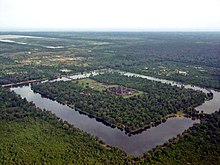Site and plan
Angkor Wat, situated at 13°24′45″N 103°52′0″E/13.41250°N 103.86667°E, is an exceptional mix of the sanctuary mountain, the standard configuration for the realm's state sanctuaries and the later arrangement of concentric exhibitions.
General plan of Angkor Wat with central structure in the middle
The sanctuary is a representation of Mount Meru, the home of the divine beings: the focal quincunx of towers symbolizes the five crests of the mountain, and the dividers and channel the encompassing mountain extents and sea. Access to the upper zones of the sanctuary was logically more restrictive, with the common people being conceded just to the most reduced level.
Not at all like most Khmer sanctuaries, Angkor Wat is arranged toward the west instead of the east. This has driven numerous (counting Maurice Glaize and George Coedès) to reason that Suryavarman expected it to serve as his funerary sanctuary. Additional proof for this perspective is given by the bas-reliefs, which continue in a counter-clockwise course—prasavya in Hindu phrasing—as this is the converse of the typical request. Ceremonies occur backward request amid Brahminic memorial service administrations. The paleontologist Charles Higham likewise portrays a holder which might have been a funerary container which was recuperated from the focal tower. It has been assigned by some as the best use of vitality on the transfer of a cadaver. Freeman and Jacques, notwithstanding, take note of that few different sanctuaries of Angkor withdraw from the normal eastern introduction, and recommend that Angkor Wat's arrangement was because of its devotion to Vishnu, who was connected with the west.
Not at all like most Khmer sanctuaries, Angkor Wat is arranged toward the west instead of the east. This has driven numerous (counting Maurice Glaize and George Coedès) to reason that Suryavarman expected it to serve as his funerary sanctuary. Additional proof for this perspective is given by the bas-reliefs, which continue in a counter-clockwise course—prasavya in Hindu phrasing—as this is the converse of the typical request. Ceremonies occur backward request amid Brahminic memorial service administrations. The paleontologist Charles Higham likewise portrays a holder which might have been a funerary container which was recuperated from the focal tower. It has been assigned by some as the best use of vitality on the transfer of a cadaver. Freeman and Jacques, notwithstanding, take note of that few different sanctuaries of Angkor withdraw from the normal eastern introduction, and recommend that Angkor Wat's arrangement was because of its devotion to Vishnu, who was connected with the west.
A further understanding of Angkor Wat has been proposed by Eleanor Mannikka. Drawing on the sanctuary's arrangement and measurements, and on the substance and course of action of the bas-reliefs, she contends that the structure speaks to an asserted new period of peace under King Suryavarman II: "as the estimations of sun based and lunar time cycles were incorporated with the sacrosanct space of Angkor Wat, this celestial order to manage was secured to blessed chambers and halls intended to sustain the ruler's energy and to respect and pacify the divinities show in the sky over." Mannikka's proposals have been gotten with a blend of hobby and incredulity in scholarly circles. She separates herself from the theories of others, for example, Graham Hancock, that Angkor Wat is a piece of a representation of the heavenly body Draco.
Style
Angkor Wat is the prime case of the traditional style of Khmer design—the Angkor Wat style—to which it has given its name. By the twelfth century Khmer engineers had ended up gifted and sure about the utilization of sandstone (as opposed to block or laterite) as the principle building material. The vast majority of the unmistakable territories are of sandstone pieces, while laterite was utilized for the external divider and for concealed basic parts. The coupling operators used to join the squares is yet to be recognized, albeit characteristic gums or slaked lime has been recommended.
The temple has drawn praise above all for the harmony of its design. According to Maurice Glaize, a mid-20th-century conservator of Angkor, the temple "attains a classic perfection by the restrained monumentality of its finely balanced elements and the precise arrangement of its proportions. It is a work of power, unity and style."
The temple has drawn praise above all for the harmony of its design. According to Maurice Glaize, a mid-20th-century conservator of Angkor, the temple "attains a classic perfection by the restrained monumentality of its finely balanced elements and the precise arrangement of its proportions. It is a work of power, unity and style."
Structurally, the components normal for the style include: the ogival, redented towers molded like lotus buds; half-exhibitions to expand paths; pivotal displays associating fenced in areas; and the cruciform porches which show up along the principle hub of the sanctuary. Run of the mill enriching components are devatas (or apsaras), bas-reliefs, and on pediments broad festoons and story scenes. The statuary of Angkor Wat is viewed as moderate, being more static and less elegant than prior work. Different components of the configuration have been decimated by plundering and the progression of time, including plated stucco on the towers, overlaying on a few figures on the bas-reliefs, and wooden roof boards and entryways.





No comments:
Post a Comment